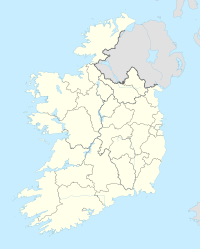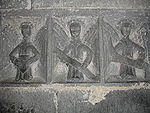Clonfert
Clonfert ( Irish ): Cluain Fearta , ( German "Small Fort" ) is a small village in the east of County Galway , Ireland . It is between Ballinasloe and Portumna .
The place is best known for its architecturally significant cathedral . Clonfert is the original seat of the Diocese of Clonfert . With 24 parishes, it is the smallest in Ireland today.
Clonfert Cathedral
The oldest parts of today's cathedral date from the 12th century and belong to the Irish late Romanesque . The east window falls below this. The choir arch, decorated with angels , a mermaid and rosettes , and the ornate arches of the side aisles date from the 15th century.
The portal of five staggered and ornamented half-columns and the six arches under the triangular tympanum with têtes coupées make the small cathedral of to a high point of the Romanesque architectural style in Ireland.
In the cemetery by the cathedral there is a high cross that is not old, but was kept in the style of the old crosses.
history
The forerunner of this church was founded in the east of County Galway near the Shannon and not far from Clonmacnoise by St. Brendan (the Navigator), in 577, on the land of the clan of Hy Many or O'Kelly.
At its peak, the Clonfert School is said to have provided training to 3,000 monks . Clonfert was chosen to be the center of a diocese at the Rathbreasail Synod in 1111 . This was affirmed at the Synod of Kells-Mellifont in 1152 when Clonfert came to the Archdiocese of Tuam . In 1175, Abbot Concors was one of those sent to Windsor by King Roderick O'Connor to sign the Treaty of Windsor . Through him, Roderick gave up the scepter and the Kingdom of Ireland. In the 12th century, Turlough O'Connor and St. Malachy founded the Augustinian monastery of St. Mary de Porto Puro near Clonfert.
In 1152 (according to other sources in 1161) Peter Ó Mordha, the abbot of Boyle Abbey, became the new abbot. In 1167 he had the great cathedral built. He drowned in the Shannon in 1172 on the way to the Cashel Synod . In 1266, according to the annals of Lough Ce , a certain John (John) was sent from Rome as bishop to reside in Clonfert. Because of the sanctions of the Engl. However, the crown could not be introduced without the help of Walter de Burgo, the Earl of Ulster . So he was ordained Bishop of Clonfert in Athenry, England . He was later appointed papal nuncio . A letter from John XXI. (1276) authorizes him to collect the tax for the crusades . John was one of the few Italian prelates ever appointed in Ireland. He was a great benefactor of his cathedral and is believed to have donated the statues and carvings that adorn the west end of the cathedral. After leading Clonfert for 30 years, he was appointed Archbishop of Benevento in Italy by the Pope in 1296 .
anecdote
The fact that the ancient Celtic tree cult is still present in Ireland is shown by a wish tree adorned with colorful ribbons and accessories, which is located close to the cathedral and a cloutie well in the forest.
| Three details from inside the cathedral and one from the tymphanon: | |||||
|---|---|---|---|---|---|
literature
- Peter Harbison : Guide to the National Monuments in the Republic of Ireland . Gill & Macmillan, Dublin 1992, ISBN 0-7171-3239-0 .
- Jacqueline O'Brien, Peter Harbison: Old Ireland. From early history to the late Middle Ages ("Ancient Ireland"). Bechtermünz-Verlag, Augsburg 1997, ISBN 3-86047-173-2 .
Web links
Individual evidence
- ^ Cloutie well, Munlochy, Ross and Cromarty ( English ) National Museums of Scotland (NMS).
Coordinates: 53 ° 12 ′ N , 8 ° 8 ′ W






